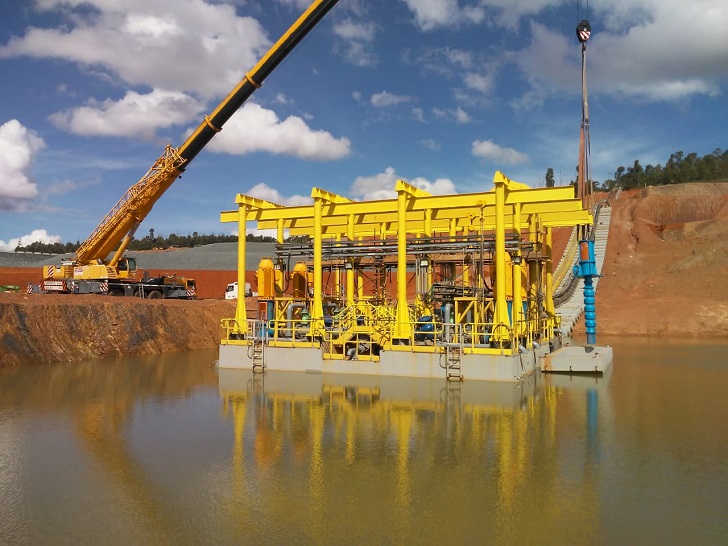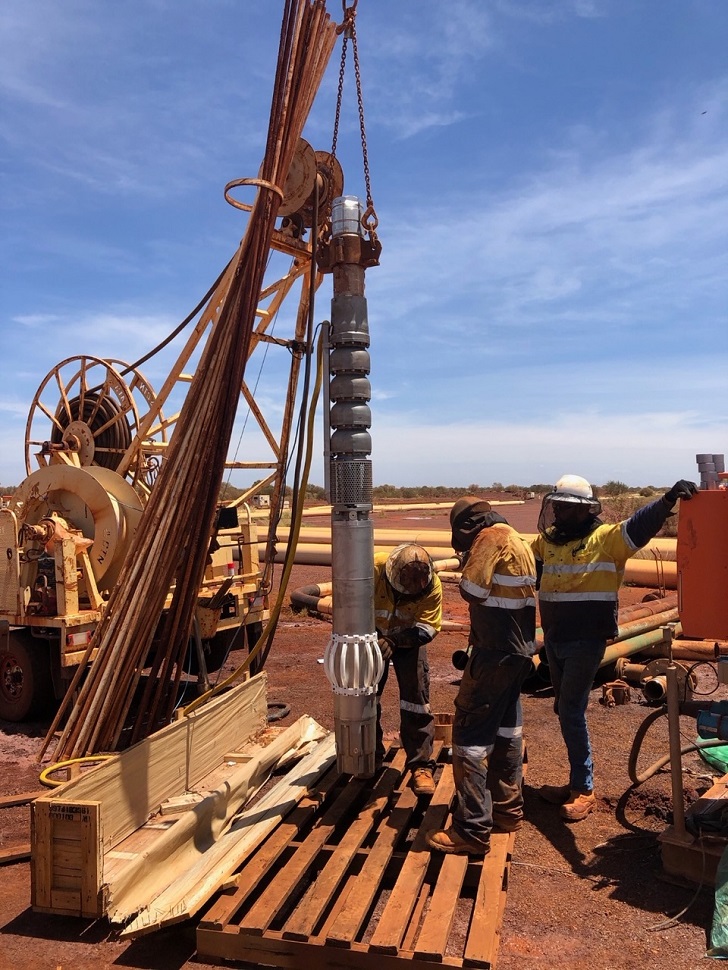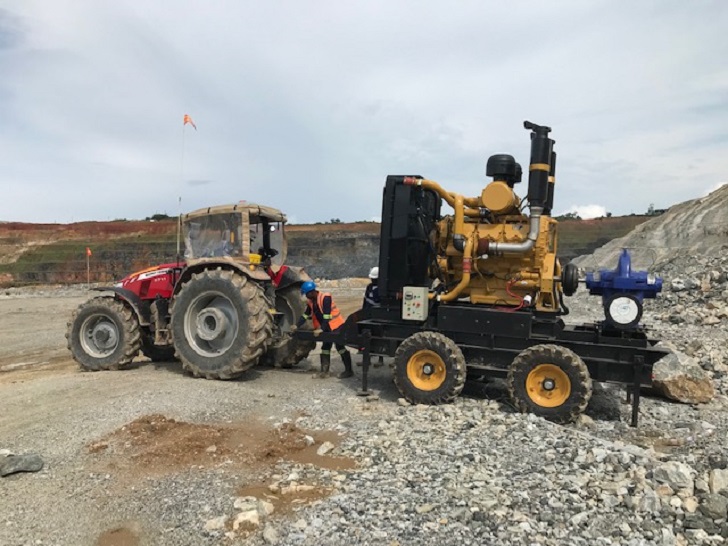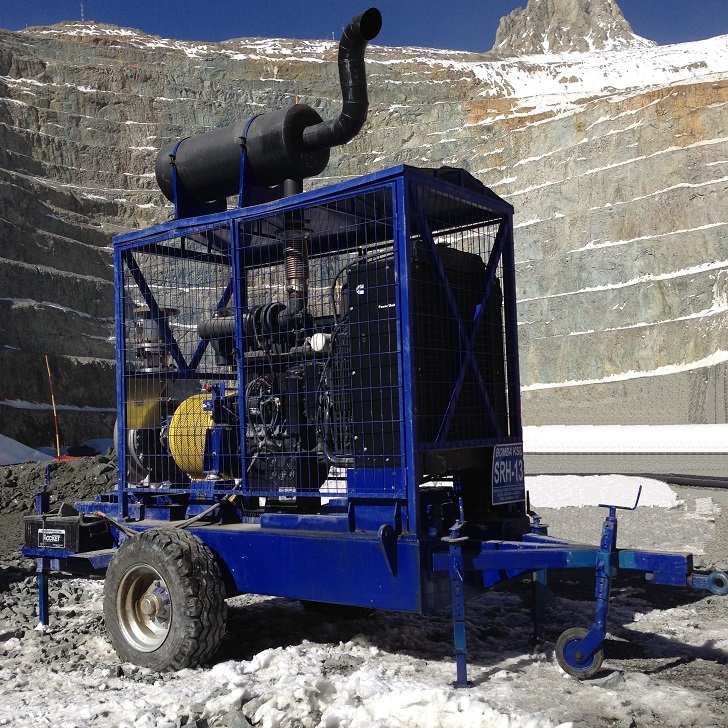



Mining operations require dewatering and the safe disposal of potentially contaminated water. KSB’s systems offer the efficient lowering of groundwater in open pit dewatering, underground drainage and borehole drainage applications regardless of a mine’s location.
Water is present everywhere in mining and its control varies according to its role in the mining processes. This in turn influences the selection of technologies used in pumping water. Alongside the safe supply and recovery of process water is the challenge of removing ground water. Process water and groundwater contain abrasive and corrosive elements in varying quantities which have an adverse affect on pump performance and life.
Working conditions, remote locations, varying temperature ranges and the lack of electric power are also highly influential factors. The copper mines in Chile and the iron ore mines in Western Australia may be many thousands of miles apart, but these mining operations still require dewatering and the safe disposal of potentially contaminated water. The same can be said of the coal mines of Mozambique and the silver mines of Mexico.
What they all have in common is a requirement for efficient and effective water and slurry pumps. Well-matched solutions help to maximise the longevity and efficiency of the system and also optimise cost-performance ratios, all attributes fulfilled by KSB’s Hard Rock Mining Division.
New techniques The search for more rare and precious minerals and metals has opened up mining in countries and locations where previously the industry was small scale or non-existent. Consequently, mining companies and equipment manufacturers have had to develop new techniques and products. And with the major mining companies having operations in many global locations, becoming a preferred equipment supplier is essential.
“The dewatering market is slowly shifting from a pure CAPEX point of view to an increasingly OPEX perspective,” reports Brett Lewis, Mining Manager at KSB Australia. “This is especially true for the large mines that realise that poorly designed equipment that regularly fails, causes a significant increase in replacement and servicing cost. Some mining companies are now committing to a carbon neutral target in the next 20 to 30 years, so are focussing on high efficiency equipment. They want to phase out diesel reliance by connecting most bores to their local electrical grid.”
KSB is aware that mining companies are recording pump performance and are accumulating data to compare brands and better rank their qualities or deficiencies. This is good news for KSB as the company is committed to delivering high reliability and efficiency pumps, so helping to reduce the carbon footprint of mining dewatering operations.
‘A one-fits-all’ pump solution? The answer to this is a resounding ‘no’, but by sharing experiences between offices and also frequently working with the same international mining companies, KSB has been able to develop appropriate solutions. KSB’s involvement in the iron ore industries in Brazil and Australia demonstrates two different approaches to dewatering, both employing vertical multi-stage pumps.
In Brazil’s Minas Gerais State open pit iron ore mines excessive ground water, monsoons and underground lakes are problems. To maintain continuous production water has to be pumped to a dewatering lake which has a dynamic water level that must be raised two or three times a year. KSB Brazil’s solution is a floating station fitted with KSB vertical turbine B pumps positioned over a pontoon (Figure 1). The pontoon rises and falls with changes in the water level so there is no need for the pumps to be repositioned. This results in cost-savings to the customer. After 20 successful years it has become the standard for this type of equipment in South America.
“The floating station supporting the pumps over the pontoon delivers the flow rate requested by the customer,” explains Jardel Ribeiro, sales manager, KSB Brazil. “Sometimes the pumps, high power motors and associated equipment results in the size of the floating station being increased. Stabilising equipment that weighs more than 200 tonnes requires a lot of planning, in addition to the challenge of building a system in such a remote area.”
Boreholes in Australia In the Pilbara Region of Western Australia iron ore is mined in several locations around the Chichester hub zone, an area between 5 and 9 km wide and 80 km long. The mineral deposit sits between 90 m and 117 m below the surface. With the ground water and water table regularly replenished in wet seasons and cyclones adding to the inundation, more than 75% of the iron ore is below the water table. If too much water mixes with iron ore, it becomes low grade and unsuitable for export, which results in massive revenue losses. Also, surface dewatering processes are extremely costly if the water is very high.
The accepted dewatering process within the region is to pump the water out through boreholes. However, this is not without its challenges. High water temperatures and high salinity result in excessive corrosion, whilst iron bacteria can grow on motors which prevent efficient motor cooling. The presence of gas is a constant threat in some areas as this causes gas lock on the impellers resulting in heavy vibrations, which places a great strain on the motor, loss of flow rate and motor failure.
This means that standard off-the-shelf products are not always suitable and the incidence of failures is high. Typically, most bore pumps fail within 12 months, and sometimes only a few weeks. At its Hope Valley facility in Western Australia, KSB provides mine operators with its UPA multistage borehole pump (Figure 2), customized to withstand site conditions. Although a more expensive product than its competitors, the UPA has been shown to deliver a significantly longer working life and reduced costs of ownership. KSB’s proprietary technology that inhibits the growth of iron bacteria makes the UPA a winner.
Trailer mounted units In Africa the environment and minerals being mined require innovative approaches to dewatering. In the Katanga Province of the Democratic Republic of Congo, home to several open cut and underground copper mines rainy seasons wreak flooding havoc. Here, KSB is delivering several different pumping solutions involving both UPA Z borehole pumps and surface-mounted Omega pumps.
“To prevent mining operations from being shut down, a fast localised response is required,” says Rob Bond, area manager Mining-Sub-Saharan Africa. “Our solution has been to supply Omega pumps mounted on rough terrain trailers (Figure 3). We supply a complete package made up of the pump, engine/ motor, couplings, gearbox, hydraulic drives and auxiliary equipment including vacuum pump, control panels, monitors etc that delivers high head pumping.”
A similar solution is also provided for the open cast Moatize coal mine in Mozambique where the water levels must remain low for continuous production reliability. Whilst borehole pumps offer good reliability on a constant basis, when the rainy season starts and more resources are in demand KSB SA provides skid-mounted Omega units. To date, KSB SA has supplied 152 units and all are working reliably.
South America In Mexico’s Zacatecas silver mines underground water is a constant problem. According to Roberto Valenzuela, sales manager Mining KSB Mexico, the water contains solid particles so the high pressure encapsulated UPA borehole pumps should be wear-resistant for long term efficiency. Because the dewatering pumps work at a high speed, the impellers and the wear ring can suffer from premature wear.
Using Multitec horizontal multistage pumps with KSB’s C6 standard chrome coating, wear is greatly minimised. “We have had pumps running in this mine for over two years without the impellers being changed, “says Roberto Valenzuela. “It is a solution that no competitor offers, and adds value for the customer through reduced maintenance, spare parts and greater mining uptime.”
In Chile’s Atacama Desert copper and gold is mined at altitudes ranging between 2000 m and 4500 m. Remote sites, mine depths and the unavailability of electricity needed to drive high capacity pumps complicate dewatering. High volumes of water contaminated by minerals can delay drilling and blasting and result in environmental pollution. KSB Chile has met these challenges by supplying encapsulated borehole pumps and cantilevered Etanorm pumps, driven by diesel motors.
“Our customers require high-pressure pumps in a modular configuration that can be moved with the expansion of the open pit,” comments Patricio Araya, mining head KSB Chile. “The solution is to use horizontally positioned borehole pumps with a special configuration for sand filters encased in a pressure shroud. This gives the customer flexibility and versatility because the equipment is compact, develops high pressures and is easy to move around the site.”
To accommodate increasing flows and discharge pressure pumps are configured in series and in parallel specifically for the client’s requirements. Being coupled to diesel engines allows continuous, autonomous operation in places without electricity for between 12 and 24 hours without refuelling (Figure 4). Vertical Etanorm pumps and cantilever-type UPA pumps installed on a raft enabling them to handle the accumulation of water inside the mine, eliminating factors such as negative suction head at high altitudes.
KSB equipment for mine drainage is supplied in standard versions, with variations for rafts or well pumps installed in pressure jackets. Having viable solutions for dewatering adds value to the customers operations and is also important because each year minerals are found at deeper levels.
Innovation in Indonesia Indonesia is one of the world’s largest exporters of thermal coal, and also a major player in copper, gold, tin, bauxite, and nickel. Here, KSB pumps are acknowledged for their outstanding capacity to perform in severe open pit mine sites. Its development of dewatering and dredge pump sets (DnD), as a solution for mining applications, especially for open-pit mine sites is one example of KSB’s commitment to continuous product improvement and development.
To date, more than 260 DnD pumps with GWI LCC and LSA pumps have been installed in mines across Indonesia and South East Asia. In 2013, KSB Indonesia launched a new model, the DnD Cruiser with enhancements requested by customers.
KSB builds the entire diesel driven pump unit on a barge, complete with fuel tank, vacuum pump, control panel etc., and ships them on trailers for easy commissioning at site. Because monsoon rains are seasonal, dewatering is also a seasonal activity and this means pumps can stand idle for several months during the dry periods.
Recognising this situation, KSB has introduced a rental programme, whereby the pumps are supplied fully-kitted out according to the customer’s requirements. By not having to purchase the pump sets, customers are relieved of the costs of ownership and know that when they require units, they come ready for operation.
Summary KSB’s mine dewatering systems enable the safe and efficient lowering of groundwater in open pit dewatering, underground drainage and borehole drainage applications. Regardless of a mine’s location, the type of mining operation being carried out, the geological and the aggressive and corrosive nature of the water, KSB has fluid handling technologies that will fit all eventualities.
This situation has come about through the cross-fertilisation of ideas, technologies and experiences gained over many decades by its companies around the world, supported by extensive investment in research and development. Wherever a pumping solution is required, KSB can bring a co-ordinated response to the table.






